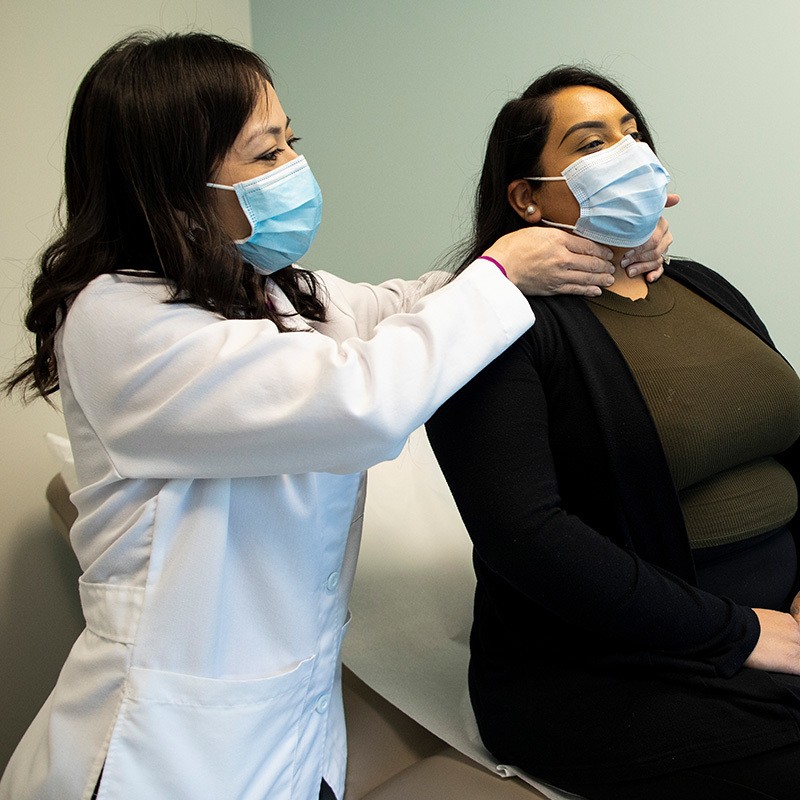Continuous Glucose Monitoring

Overview
What is Continuous Glucose Monitoring?
A continuous glucose monitor (CGM) is a device that automatically tracks your blood sugar (glucose) levels continuously day and night. You can easily see your glucose levels in real-time. Seeing your real-time glucose levels can help you make better decisions about balancing your food, physical activity, and medicines throughout the day. You can also track your historical data as well. Frequently patients use their CGM in combination with insulin pump therapy.
A Certified Diabetes Educator or Medical Assistant will place a sensor on the back of your arm or your abdomen, inserting a fine sensor wire under your skin. This sensor will measure your glucose level every few minutes and send the information for you to view on a compatible receiving device or smartphone.
CGMs have alarms to alert you if your glucose levels are too high or too low. Most CGMs allow you to note your meals, activity, and medicines along with your glucose levels. You can also download the information collected by your CGM to a computer or other smart device. Some models allow you to share this data to a second smartphone – perhaps to your support person’s device.
Why
Why Continuous Glucose Monitoring?
Using a CGM can help you better manage your glucose levels and have fewer glucose-related emergencies. The graphics on the CGM screen show if your blood sugar levels are rising or dropping so you can adjust your medication or activities to reach your target glucose level. When you use a CGM, you will need fewer finger sticks than a standard blood glucose meter.
A CGM will help you stay healthy and prevent complications of diabetes. People who gain the most significant benefit from a CGM use it every day or nearly every day.

Risks
Continuous Glucose Monitoring Potential Risks and Complications
Continuous glucose monitors (CGMs) are not always 100% accurate, so you may still need to test your blood sugar manually for backup. CGMs can be inaccurate for two reasons:
- The sensor measures your glucose level based on the interstitial fluid (the fluid between your cells) and not the blood level.
- This technology just isn’t perfect yet.
It is dangerous to become too reliant on CGM sensor readings only. You must also pay attention to what your body is telling you and do manual finger sticks anytime anything seems off. You must take immediate action when your CGM alerts you about high or low blood glucose and follow your treatment plan to bring your glucose into the target range or get help.
CGM sensors are attached to your body continuously until removal, which can become annoying, although many people don’t even notice. You may need to move the CGM to different parts of your body depending on your activities. You will also need to replace the CGM sensor every 7 to 14 days, depending on the model.
CGMs cost more than a standard glucose meter. Check with your insurance plan to see if it will cover all or part of the cost.

Prep
Preparing for Continuous Glucose Monitoring
Before using a CGM, you must:
- Know how to do manual finger sticks and verify you have all the supplies you need including, glucometer, lancets, and test strips
- Become familiar with your CGM and how it works
- Be aware of what can go wrong with your CGM and how to fix it – have a plan B
- Have a support person who will learn with you so they can help you when needed
- Make sure you have written instructions on how to operate your CGM
- Watch videos of how to use your model of CGM
- Figure out multiple locations for wearing your CGM
- Bring your list of questions to your doctor
- Start checking your blood glucose multiple times daily if insurance requires for coverage

What to expect
What to Expect with Continuous Glucose Monitoring
Although you won’t be able to stop doing manual sticks altogether, even with CGM, you will be able to reduce the need for manual sticks significantly.
At your doctor’s office, you may be taught by a Medical Assistant or a Certified Diabetes Educator how to insert, remove, and use a CGM properly. Once you learn how to do this, you can self-manage the sensor and do placement and removal yourself at home. When your educator first places the sensor, you may feel a pinch sensation, and some individuals may continue to feel the sensor at the insertion site for a day or two, but many people don’t even notice.
There are no short- or long-term side effects after sensor placement, other than perhaps feeling the sensor in the arm. You can safely drive yourself home after your educator places your sensor.
Your doctor’s office or the Certified Diabetes Educator will discuss with you a follow-up plan. Often it is best to schedule a short interval follow-up so your doctor can interpret the information from the CGM.
Specialists

